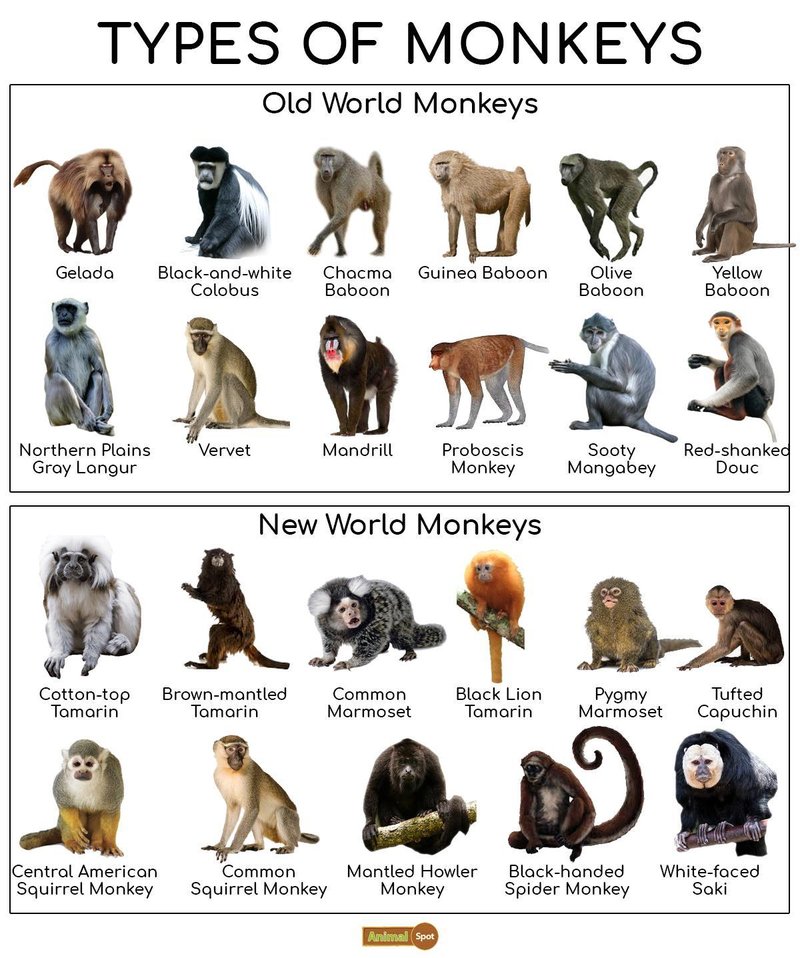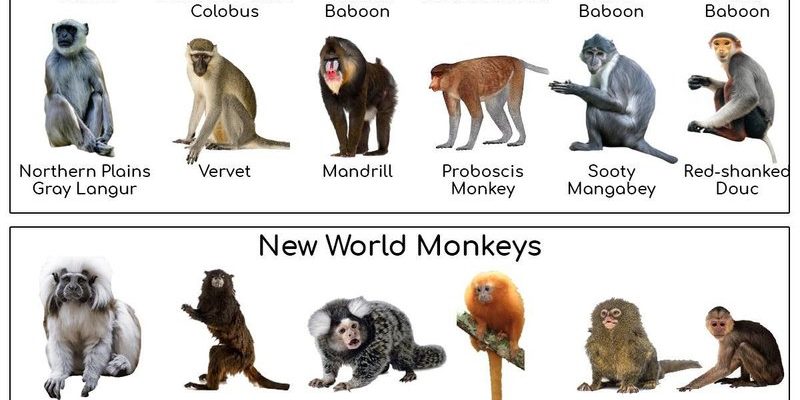
Imagine sitting with your best friend over coffee, chatting about your latest trip to the zoo. You might spot a monkey swinging about and think, “Wait, isn’t that a lemur?” or “That looks like a tiny chimpanzee!” It’s easy to mix them up since some creatures share similar features or behaviors. Let’s dive into these animals and learn how to tell them apart, so you can impress your friends with your newfound knowledge!
1. Apes
When we think about animals that are similar to monkeys, apes often come to mind first. They belong to the same primate family, but here’s the thing: they’re not the same! Apes include species like gorillas, chimpanzees, and orangutans. Unlike monkeys, apes don’t have tails. They’re more closely related to humans than they are to most monkeys, which is fascinating.
Apes are typically larger and more powerful than monkeys. For instance, a gorilla can weigh over 400 pounds! While monkeys might spend their days swinging from branch to branch, apes are more likely to move about on their knuckles. You can easily distinguish an ape from a monkey by looking for that absence of a tail and their impressive size.
2. Lemurs
Lemurs are another intriguing animal that often gets confused with monkeys. These primates are native to Madagascar and are known for their large, expressive eyes and long, fluffy tails. While they have some similarities to monkeys, like social structures and playful behavior, lemurs are uniquely different.
One easy way to tell lemurs apart from monkeys is by their physical appearance. Lemurs have more elongated snouts and a distinctively cute “grin,” thanks to their wide-set eyes. They also tend to be more nocturnal, which means you might catch them up and about during the night, unlike most monkeys who are active during the day. If you see an animal perched on a branch with an oversized tail and eyes shining in the moonlight, it’s probably a lemur!
3. Tarsiers
Now, let me introduce you to tarsiers! These tiny primates are mostly found in Southeast Asia and are known for their large, round eyes that almost seem too big for their heads. Tarsiers are unique because, despite being small like some monkeys, they are not closely related to them.
You might be wondering how to spot a tarsier. Besides those oversized eyes that help them see well in the dark, they have unparalleled agility. Tarsiers can leap distances of up to 10 feet! They also have a unique grooming behavior, where they often clean their fur meticulously, a trait that sets them apart from other primates, including monkeys.
4. Capuchin Monkeys
Capuchin monkeys are perhaps one of the more recognizable monkey species, often seen in movies or as pets. With their cream-colored faces and dark bodies, they have a charming look that makes them stand out. These monkeys are known for their intelligence and adaptability.
To tell a capuchin apart from other monkeys, look at their social behavior. They are highly interactive and often work in groups, displaying teamwork when foraging for food. They also show tool use, like using stones to crack nuts. So, if you’re observing a monkey and see it using tools, chances are it’s a capuchin!
5. Squirrel Monkeys
Squirrel monkeys are the little acrobats of the primate world. These small, lively monkeys are known for their agile movements and playful nature. With their small size and bright yellow-orange fur, they’re hard to miss.
When comparing squirrel monkeys to other primates, a key feature is their facial markings. They have a distinctive black “mask” around their eyes, which adds to their charm. They also have smaller bodies compared to larger monkeys, which gives them the ability to leap swiftly from branch to branch. If you see a tiny monkey darting around with a mischievous grin, it’s likely a squirrel monkey!
6. Gibbons
If you’ve ever heard a strange, beautiful song wafting through the trees, you might have stumbled upon gibbons. These monkeys, found in the forests of Asia, are known for their incredible vocalizations and swinging skills. Gibbons are unique among primates because they move through the trees using their arms in a method called brachiation.
What sets gibbons apart from many other primates is their social structure. They often mate for life and live in small family groups, which is different from many monkey species that might live in larger troops. Their long arms and lack of tails make them stand out. If you see a monkey gliding gracefully through the trees with a melodious call, you’ve likely found a gibbon.
7. Marmosets
Marmosets are tiny monkeys full of personality! Native to South America, these pint-sized primates are known for their tufted, white ear hair and playful demeanor. They’re often mistaken for larger monkeys due to their active nature, but their small size is one of their defining characteristics.
The easiest way to identify a marmoset is by its size and the way it communicates. They tend to make a variety of high-pitched sounds and are very social, often living in family groups. If you see a monkey that’s tiny, has fluffy ears, and is constantly chattering, then you have a marmoset on your hands!
8. Spider Monkeys
Spider monkeys are some of the most agile and graceful monkeys you’ll encounter in the wild. They’re known for their long limbs and prehensile tails, which act like a fifth limb. This allows them to swing effortlessly through the trees, giving them a spider-like appearance.
To tell a spider monkey apart from others, observe its tail. Unlike many monkeys, their tails are capable of grasping branches, which is a handy adaptation for life in the treetops. Their social structure is also interesting. Spider monkeys tend to live in large groups, but they lead a more fluid lifestyle compared to some of their relatives. If you see a monkey hanging upside down with its tail curled around a branch, it’s probably a spider monkey!
9. Howler Monkeys
Howler monkeys are known for their impressive vocalizations that can be heard over long distances – hence the name! Native to Central and South America, these monkeys have a distinctive appearance, often with fluffy fur and bushy tails.
Spotting a howler monkey is easier if you listen for their haunting calls echoing through the forest. They are also heavier and larger than many other monkeys. If you see a bulky monkey lounging in a tree with a deep voice, you’re likely hearing a howler monkey, making its presence known.
10. Baboons
Finally, let’s talk about baboons! These monkeys are some of the largest, with strong builds and distinct faces. They’re known for their complex social structures and adaptability. Baboons can be found in various environments across Africa and are often seen foraging in groups.
To tell baboons apart from other monkeys, look at their prominent canine teeth and the way they interact socially. Baboons have a strict hierarchy and complex communication methods, which makes them unique among primates. If you see a larger monkey with a colorful rear and commanding presence, chances are it’s a baboon.
Wrapping It Up
So there you have it! We’ve explored ten animals similar to monkeys and what makes each one unique. From the clever capuchin to the melodious gibbon, each species has its own charm and characteristics. Now that you know how to tell them apart, you can be the go-to expert among your friends during your next adventure at the zoo or in nature. Whether you’re spotting lemurs in Madagascar or howler monkeys in Central America, you’ll have a deeper appreciation for these fascinating creatures and their quirks.

